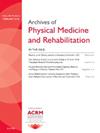比较两种不同的肉毒毒素注射技术对偏瘫患者腓肠肌痉挛的疗效:随机双盲对照研究。
IF 3.6
2区 医学
Q1 REHABILITATION
Archives of physical medicine and rehabilitation
Pub Date : 2025-03-01
DOI:10.1016/j.apmr.2024.09.011
引用次数: 0
摘要
目的比较神经支配区靶向注射技术(EUROMUSCULUS/USPRM痉挛方法)和沿肌肉长度注射技术的疗效:双盲随机对照试验:参与者: 100 名患有踝关节足底痉挛的中风患者:100 名患有踝关节跖屈痉挛的中风患者:在注射前和注射后一个月使用改良阿什沃特量表、改良Tardiue量表、踝关节活动范围测量和10米步行测试:除常规康复治疗外,符合条件的患者被随机分配到两组。实验组沿肌肉长度方向注射肉毒杆菌毒素,而对照组则在腓肠肌内侧头近端25%-35%处和外侧头近端20%-30%处注射相同剂量和体积的肉毒杆菌毒素:60名参与者完成了研究,平均年龄为(59.96±12.15)岁。两种注射方法对活动范围、痉挛程度、活动能力和行走速度均有效。结论:两种 A 型肉毒毒素注射方法产生的临床效果相似。本文章由计算机程序翻译,如有差异,请以英文原文为准。
Comparison of the Efficacy of 2 Different Botulinum Toxin Injection Techniques in Gastrocnemius Muscle Spasticity in Hemiplegic Patients: A Randomized Double-Blind Controlled Study
Objective
To compare the efficacy of the innervation zone–targeted injection technique (EUROMUSCULUS/USPRM (Ultrasound Study Group of the International Society of Physical and Rehabilitation Medicine) spasticity approach) and the injection technique along the muscle length.
Design
A double-blind randomized controlled trial.
Setting
Department of rehabilitation medicine of a medical center.
Participants
One hundred patients with stroke experiencing ankle plantar flexor spasticity.
Interventions
In addition to conventional rehabilitation, eligible patients were randomly assigned to 2 groups. The experimental group was injected with botulinum toxin along the length of the muscle, whereas the control group was injected with the same dose and volume of botulinum toxin 25%-35% proximal to the medial head and 20%-30% proximal to the lateral aspect of the head of the gastrocnemius muscle.
Main Outcome Measures
Modified Ashworth scale, modified Tardieu scale, ankle range of motion measurement, and 10-meter walk test were used before and 1 month after injection.
Results
The study was completed by 60 participants with a mean age of 59.96±12.15 years. Both injection methods were found to be effective on range of motion, spasticity level, ambulation, and walking speed. There was no statistically significant difference between injection methods.
Conclusions
Both injection methods of botulinum toxin A produce similar clinical effects.
求助全文
通过发布文献求助,成功后即可免费获取论文全文。
去求助
来源期刊
CiteScore
6.20
自引率
4.70%
发文量
495
审稿时长
38 days
期刊介绍:
The Archives of Physical Medicine and Rehabilitation publishes original, peer-reviewed research and clinical reports on important trends and developments in physical medicine and rehabilitation and related fields. This international journal brings researchers and clinicians authoritative information on the therapeutic utilization of physical, behavioral and pharmaceutical agents in providing comprehensive care for individuals with chronic illness and disabilities.
Archives began publication in 1920, publishes monthly, and is the official journal of the American Congress of Rehabilitation Medicine. Its papers are cited more often than any other rehabilitation journal.

 求助内容:
求助内容: 应助结果提醒方式:
应助结果提醒方式:


